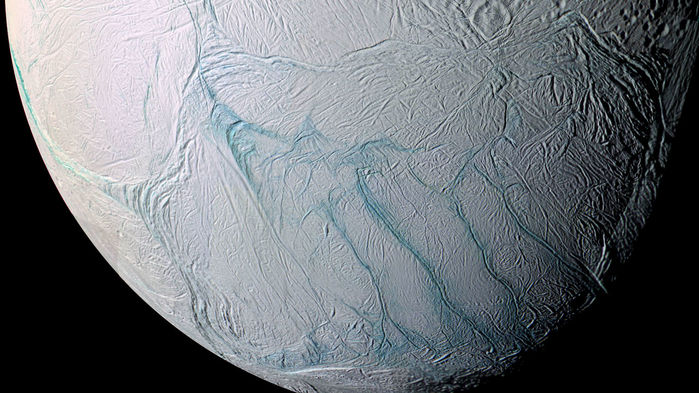Among the most remarkable geophysical features in the solar system are four fissures—nicknamed tiger stripes—that streak across Saturn's moon Enceladus. Liquid water from this moon's interior erupts from these 130-kilometer- (80-mile-) long clefts onto Enceladus' otherwise bright-white surface. Ever since the stripes' discovery in May 2005 by the Cassini spacecraft, researchers have puzzled over why the stripes run nearly in parallel, are evenly spaced about 35 km (22 mi) apart, and only occur near the moon's south pole. A new theory now offers a comprehensive explanation for all three of these characteristics. The theory could help scientists better understand Enceladus in its entirety, which—along with Mars and Jupiter's moon Europa—is considered a top-tier candidate for potentially hosting extraterrestrial life. See also: Astrobiology; Cassini-Huygens mission; Enceladus; Saturn

An initial clue for explicating the origin of the tiger stripes is the way in which Enceladus is constructed. Models suggest that the moon's thin, frozen shell hides an internal, global ocean more than 30 km (20 mi) deep, sloshing atop a rocky core. Tidal heating keeps this internal ocean liquid. As the small moon goes through its orbit around Saturn, the host planet's gravity squeezes and stretches the rocky bulk of Enceladus, causing internal friction that, in turn, generates heat. See also: Friction; Gravity; Orbital motion; Tide
Building upon this paradigm, researchers developed a new model of the forces at work in further shaping Enceladus. As water from the internal ocean inevitably freezes at the boundary with its encompassing ice shell, the shell thickens. Stresses develop in this shell because water expands in volume as it freezes. The resulting pressure in the sheet eventually causes the sheet to crack. The likeliest place for cracking to occur is at the moon's poles, where the ice shell should be at its thinnest. The pressure release from one pole giving way in this manner would be sufficient to prevent cracking of the ice shell over the other pole, the new theory suggests. With water now actively flowing through the initial crack in the shell onto Enceladus' surface and then freezing, ice loads pile up, adding significant weight onto the ice sheet. The sheet bends and eventually buckles, cracking outward in a cascading manner at regular intervals in parallel to the initial crack. The end result is the tiger stripe features. See also: Pressure; Stress and strain; Weight
The model additionally addresses why this phenomenon is unique to Enceladus, despite the fact that numerous other moons in the solar system likewise possess internal oceans, although none display tiger stripe–like surface features. Enceladus is fairly small—just 500 km (310 mi) in diameter—and not particularly massive. The world's gravity is likely too weak to hold the ice shell tightly together in a way that would prevent a series of fractures from propagating through the shell. Cleaving finally ceases at a distance where the ice loading diminishes sufficiently, or perhaps where the crust has grown thicker. See also: Satellite (astronomy); Solar system





